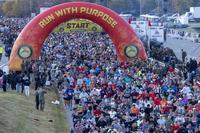The pyramid workout method is a great way to accumulate repetitions over a 19-set 1-10-1 set pyramid. In fact, with some doubling and tripling, you can accumulate a 100 pull-ups, 200 push-ups, and 300 squats (also known as the Memorial Murph Workout) in relatively easy or non-failure set fashion.
You should be used to this kind of exercise volume before attempting this workout if you are smart.
Pull-up/push-up (x2) pyramid 1-10 warmup with 100-meter jog between sets (stop at 10). Mix in some 25-meter jogs and dynamic stretches to prepare for the run and additional leg repetitions later in the workout.
Consider this a warmup: one pull-up, two push-ups -- 25 meter jog, two pull-ups, four push-ups -- 25-meter jog, three pull-ups, six push-ups, 25-meter jog. If you need to rest, take some time between sets to stretch your arms and legs.
Keep going up for 10 sets: 10 pull-ups and 20 push-ups. Now, it is time to add in a run mixed with squats done on a regular 100- to 200-meter distance:
Run 1.5 mile -- but during the 1.5-mile run, stop 10 times and do the first half of the squat 1-10 pyramid x 3:
Run 100-200 meters, three squats; run 100-200 meters, six squats; run 100-200 meters, nine squats … keep repeating this run interval and squat increases until you get to 30 squats (10 sets of the pyramid complete).
Change it up at the peak of the pyramid
After 10 sets, you are at the peak of the workout, and if you notice, you have accumulated over half of the Murph with some added running distance. (55 pull-ups, 110 push-ups, 165 squats). Hang at the peak, work some of the core elements and recover your arms and legs, then repeat everything in reverse order to complete the 100 ,200, 300 Memorial Murph Workout.
Peak of the pyramid PT reset and core work: The PT reset is a core group of exercises that work the upper back, lower back and the overall core system of muscles. These muscle groups often are neglected if performing high-repetition workouts of standard PT exercises like push-ups, sit-ups and pull-ups.
Here are some ideas to balance your hard work and help your recovery and posture at the same time:
PT reset:
Rev push-ups: 20
Birds: 20
Arm haulers: 20
Swimmers: 1 minute
Repeat 2 times
Flutter kicks: 25
Leg levers: 25
Scissors: 25
Plank pose: 1 minute
It Is all downhill from here
Run 1.5 miles, but during the run, stop nine times and do the bottom half of the squat 9-1 pyramid with squats. Repeat in reverse order from 27 to 3. This will total 300 squats for the day.
Run 100-200 meters, 27 squats; run 100-200 meters, 24 squats; run 100-200 meters, 21 squats … keep repeating this run interval and squat increases until you get to three squats (19 sets of the full pyramid complete).
After the running and squat pyramid, now it is time to cool down the upper body with the same reverse pyramid. Each set will get easier as you work down the pyramid.
Pull-up/push-up (x2) pyramid 9-1: cool down and stretch with 15-20 seconds of stretches (arms, core, legs) between sets (stop at 1):
Pull-ups x 1
Push-ups x 2
Here is the breakdown of this last part of the workout: nine pull-ups, 18 push-ups, stretch; eight pull-ups, 16 push-ups, stretch; seven pull-ups, 14 push-ups, stretch. Keep going up for nine total sets until you reach one pull-up and two push-ups resting with static stretches as desired.
Check Stew Smith’s latest 101 Best Pyramid Training Workouts book for even more ideas for workouts with weights, max effort calisthenics, cardio workouts (run, swim, bike, other) and cooldown options. It is way too easy to skip the warmup and the cooldown of a workout, but when your workout system has it built into the program, you win and will see the benefits in performance and recovery.
Stew Smith is a former Navy SEAL and fitness author certified as a Strength and Conditioning Specialist (CSCS) with the National Strength and Conditioning Association. Visit his Fitness eBook store if you’re looking to start a workout program to create a healthy lifestyle. Send your fitness questions to stew@stewsmith.com.
Want to Learn More About Military Life?
Whether you're thinking of joining the military, looking for fitness and basic training tips, or keeping up with military life and benefits, Military.com has you covered. Subscribe to Military.com to have military news, updates and resources delivered directly to your inbox.



















